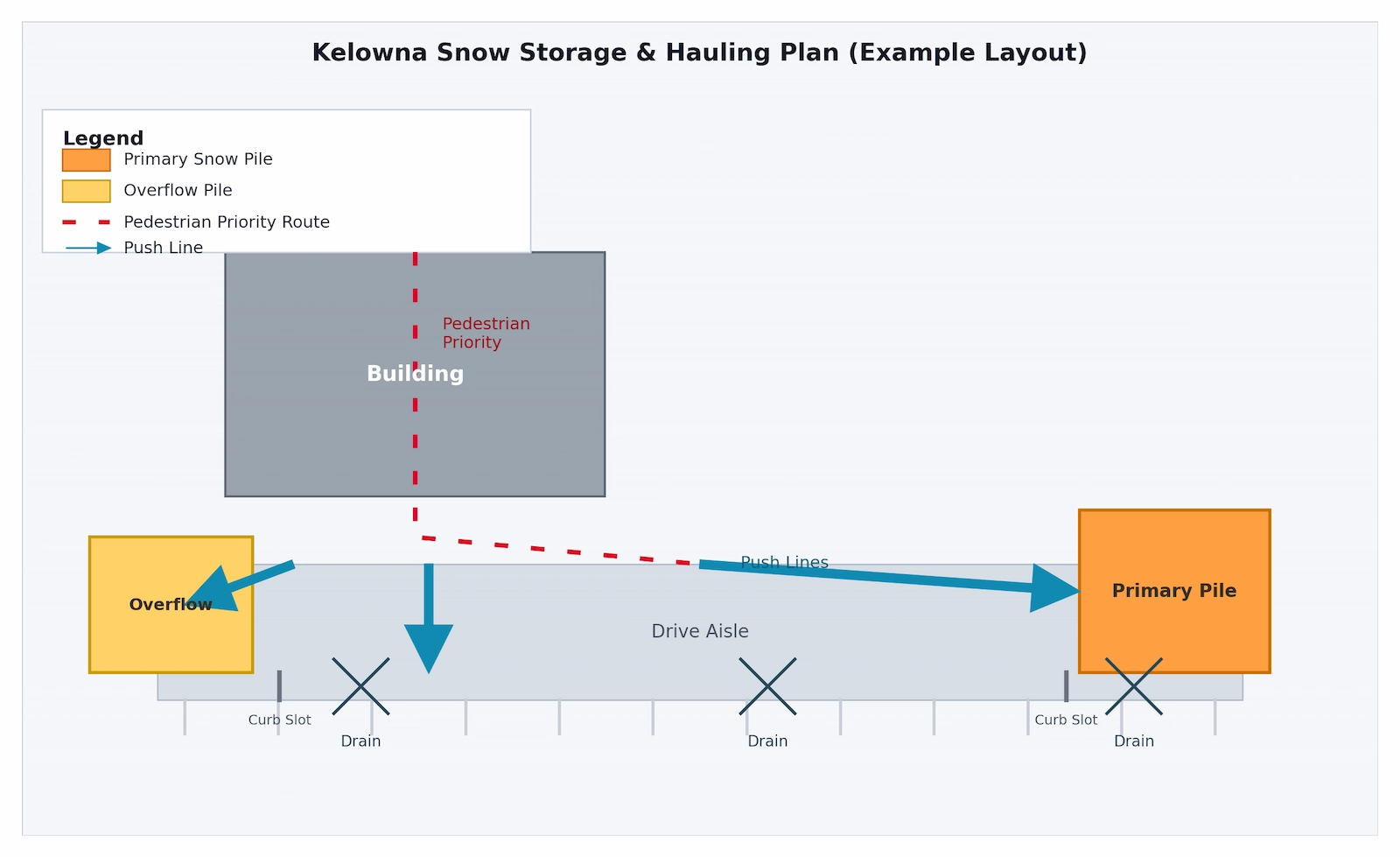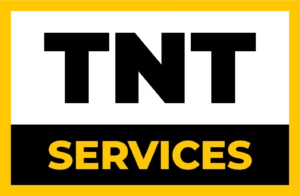
Kelowna Snow Storage & Hauling: How to Plan Safe, Efficient Snow Pile Zones for Strata & Commercial Sites
Kelowna’s freeze–thaw cycles, tight lots, and mixed pedestrian/vehicle traffic make snow storage planning just as important as clearing. Poorly placed piles can block sightlines, bury drains, flood entrances during melt, shrink parking capacity, and create refreeze hazards. A simple plan—made before the first storm—keeps your site safer, accessible, and cheaper to maintain all season.
Tip: Keep this guide with your site map and update it each year as layouts or tenants change.
Step-by-step Planning Framework
1) Map your site (5-minute walk-through)
- Catch basins & drains (including shaded ones that freeze)
- Accessible routes (ramps, curb cuts, crosswalk paths)
- High-traffic doors (main entry, mailroom, waste/recycling)
- Sightline zones (intersections, drive aisles, loading exits)
- No-pile areas (fire lanes, hydrants, utility boxes, loading docks)
2) Choose primary & overflow pile zones
- Pick spots down-gradient from doors and pedestrian routes
- Don’t cover drains—place piles near but not on grates
- Preserve sightlines at drive aisles and corners
- Favor hard surfaces with a good sub-base to prevent rutting
- Keep piles off landscaped beds to reduce salt burn
3) Protect pedestrians first
- Keep entrances, stairs, curb ramps and accessible stalls fully open
- Maintain walkway widths that allow two people to pass
- Avoid windrows across sidewalks and crosswalk paths
- Use cones or signage where melt/refreeze is expected
4) Plan meltwater paths
- Channel meltwater to drains without crossing entrances
- Cut slots at curb lines so water reaches the gutter
- Keep drain grates visible and re-open them after each event
5) Pre-define loader & blower routes
Sketch push lines and stack zones so plow trucks, blowers, and loaders don’t work against each other. This reduces time on site and stops pile creep into parking or pedestrian areas.
When to Switch from Stacking to Hauling
Trucking snow off-site (or relocating on-site) saves money and headaches when:
- Piles reduce parking capacity or block loading/ADA access
- Sightlines at exits/intersections start to disappear
- Meltwater floods entrances, ramps, or freezes into sheets
- Another storm is forecast before melt-down
- Snow is contaminated (gravel/debris) and can’t be restacked
Contract tip: Add a simple clause: “If piles encroach on marked stalls/accessible routes/sightlines, schedule hauling within 24–48 hours.”
Environmental Best Practices for the Okanagan
- Prioritize anti-icing (prevent bond) over heavy reactive de-icing
- Use targeted applications at entries, stairs, and ramps
- Keep piles off landscaped beds to reduce salt burn and spring kill
- Budget a post-season sweep to remove sand/grit from drains and curb lines
Strata-Specific Notes
- Label priority buildings/routes (mail, parcel room, waste/recycling)
- Post a resident note: park tight to lines during storms
- Assign a board contact for overnight decisions (hauling, return passes)
Commercial & Retail Notes
- Keep front-row stalls and curb ramps open for accessibility
- Protect tenant signage and sightlines from tall piles
- Align plow/loader timing with delivery windows
Build a Simple Snow Storage Map (Free Template Idea)
On a copy of your site plan, mark:
- Blue arrows = push/blower lines
- Orange zones = primary piles
- Yellow zones = overflow piles
- X = drains to keep clear (circle chronic freezers)
- Dotted red = pedestrian priority routes
Save a PDF in your site files and share it with your contractor each fall.
Quick Checklist (Print & Post in Utility Room)
- ☐ Drains marked & cleared after each event
- ☐ Entrances/stairs/curb ramps open; no windrows across sidewalks
- ☐ Piles away from sightlines, lanes, hydrants, and utility boxes
- ☐ Accessible stalls and routes maintained end-to-end
- ☐ Overflow zone ready for back-to-back storms
- ☐ Hauling trigger agreed and documented
- ☐ Post-storm recheck for refreeze zones before opening
FAQs
How close can I stack to drains?
Close enough to feed meltwater toward them, but not on top. Keep grates exposed so they remain functional and can be re-opened quickly after each event.
What causes sheet ice after a sunny day?
Daytime melt flows across cooler pavement into shaded areas and refreezes at dusk. Treat these transition zones proactively with targeted anti-ice.
Do I need different pile zones for heavy winters?
Yes—designate overflow or haul-away zones so you don’t lose stalls and sightlines during prolonged cold snaps or back-to-back storms.
Should I pile on landscaped areas to save parking?
Avoid it where possible—salt, sand, and compaction damage plants and soil. If unavoidable, plan spring remediation.
Related Services & Guides
Ready for a plan that includes storage zones, hauling triggers, and proactive anti-ice? See our Kelowna snow removal services. For a deeper primer on anti-icing vs. de-icing and winter site strategy, read the Kelowna Snow Removal Guide.
